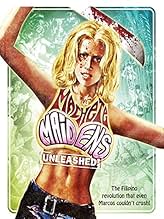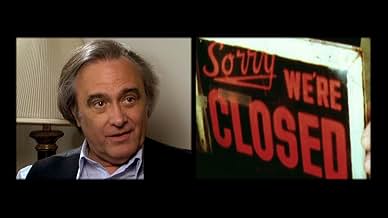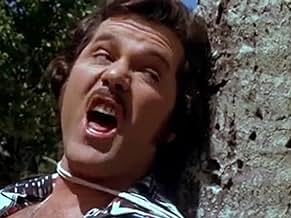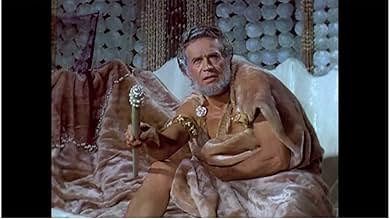NOTE IMDb
7,3/10
1,9 k
MA NOTE
Ajouter une intrigue dans votre langueA fast moving odyssey into the subterranean world of the rarely explored province of Filipino genre filmmaking.A fast moving odyssey into the subterranean world of the rarely explored province of Filipino genre filmmaking.A fast moving odyssey into the subterranean world of the rarely explored province of Filipino genre filmmaking.
- Réalisation
- Scénario
- Casting principal
Gerardo de Leon
- Self - Director
- (images d'archives)
Avis à la une
Starting from the the 1950's war pictures and ending in 1980, this documentary covers films made in the Philippines but made for American audiences or exported to America. Bomba films are not covered as they were not exported.
Interviewed are actors, actresses, directors, producers directly involved in these films or occasionally their relatives. Director John Landis curiously appears several times but I'm not aware of any involvement he had with Filipino filmmaking.
They go thru a host of low budget films, that used the Philippines location as they explain in detail was cheap. It is those particular details plus explaining the evolving political situation that steps this documentary up a few notches. Besides the films, some directors including Cirio Santiago, Bobby Suarez & others even explaining their styles & approach to the films. This is important as they influenced American filmmakers, notably Quentin Tarantino who were fans. Even Apocalypse Now was talked about.
They really stuffed a lot of related subjects and insights into this documentary. I also liked how they sometimes edited parts of interviews together as if the next person was responding to the previous one. It does help if you know or interested in filmmaking itself as that's the main focus. As a huge film buff, I was fascinated from beginning to end.
Interviewed are actors, actresses, directors, producers directly involved in these films or occasionally their relatives. Director John Landis curiously appears several times but I'm not aware of any involvement he had with Filipino filmmaking.
They go thru a host of low budget films, that used the Philippines location as they explain in detail was cheap. It is those particular details plus explaining the evolving political situation that steps this documentary up a few notches. Besides the films, some directors including Cirio Santiago, Bobby Suarez & others even explaining their styles & approach to the films. This is important as they influenced American filmmakers, notably Quentin Tarantino who were fans. Even Apocalypse Now was talked about.
They really stuffed a lot of related subjects and insights into this documentary. I also liked how they sometimes edited parts of interviews together as if the next person was responding to the previous one. It does help if you know or interested in filmmaking itself as that's the main focus. As a huge film buff, I was fascinated from beginning to end.
This film is a documentary that celebrates trash cinema--specifically, the terribly cheesy American films made in the Philippines in the 60s and early 70s. Why did they go to this country? Simple--it was dirt cheap! So, cheap film makers like Roger Corman and Eddie Romero went there to create tons of terrible films--and the filmmakers knew it was going to be bad. There was no pretense--the films featured silly monsters, women in prison and the like. And, the films had tons of action, violence and boobies. Ultimately, however, there actually was a GOOD movie made there ("Apocalypse Now") and soon after this, the industry came to a halt due to violence and revolution...and ultimately the fall of the Marcos regime.
So is all this worth seeing and celebrating? Well, it depends on you. If you occasionally LIKE to see a terrible film (such as "Black Mama, White Mama"), then you'll like seeing the documentary (that's me!). You'll relive trashy but fun films or get ideas for movies to rent (though only about half the ones mentioned in the film are available from Netflix). But, if you are sane, you'll probably just wonder why anyone would want to remember these terrible films! Overall, however, the film is worth seeing if you are the type who can appreciate it--and I sure did. Just beware...the film is violent and infused with breasts!
So is all this worth seeing and celebrating? Well, it depends on you. If you occasionally LIKE to see a terrible film (such as "Black Mama, White Mama"), then you'll like seeing the documentary (that's me!). You'll relive trashy but fun films or get ideas for movies to rent (though only about half the ones mentioned in the film are available from Netflix). But, if you are sane, you'll probably just wonder why anyone would want to remember these terrible films! Overall, however, the film is worth seeing if you are the type who can appreciate it--and I sure did. Just beware...the film is violent and infused with breasts!
A fast moving odyssey into the subterranean world of the rarely explored province of Filipino genre filmmaking.
I love horror films and exploitation films and consider myself both a critic and historian (having now reviewed over 2000 films and written numerous articles). Yet, I must confess, I was not aware of the hundreds -- perhaps thousands -- of films that were made in the Philippines. I knew about some of them, of course, but did not know just how huge the output was.
Wow! This is one of the best documentaries I have ever seen on exploitation films (and I have seen my share). John Landis never disappoints, and some unusual suspects show up, too. R. Lee Ermey? Who knew?
I love horror films and exploitation films and consider myself both a critic and historian (having now reviewed over 2000 films and written numerous articles). Yet, I must confess, I was not aware of the hundreds -- perhaps thousands -- of films that were made in the Philippines. I knew about some of them, of course, but did not know just how huge the output was.
Wow! This is one of the best documentaries I have ever seen on exploitation films (and I have seen my share). John Landis never disappoints, and some unusual suspects show up, too. R. Lee Ermey? Who knew?
Very well made, thoughtful with plenty of fun clips. Always great to hear from ever delightful insiders Jack Hill, Roger Corman, Joe Dante and Sid Haig. Not to mention the still very gorgeous Marlene Clark, Judy Brown and Celeste Yarnell! Woulda loved to see even more of the goddess Pam Grier. Nice to see Filipino artistes I only read about, like Eddie Romero and Garcia. Obviously, fans of this genre have great patience and sense of humor and the film appeals at both levels. It runs at such a fast clip; I almost wanted to slow it down to digest and savor it all.
The only downside is admittedly very subjective, that being the inclusion of John Landis. Regardless of the outcome the trial re: the Twilight Zone film: JUST GO AWAY!! It's Stomach Churning to see him laughing on camera in Any interview. WHAT?! Landis gushes on the fun of " Irresponsible Filmmakers" and actresses showing T&A....Eeeewwww. Sure, he made some great films. However, plenty of people are just as enthusiastic and knowledgeable on B-movies. Mr. Holcomb and DeoCampo contributed erudite commentary and historical perspective. Does this dude not realize that 3 FAMILIES are still affected by the Very Preventable deaths that occurred under his watch?!?. Without Landis' presence, this film is Aces!
The only downside is admittedly very subjective, that being the inclusion of John Landis. Regardless of the outcome the trial re: the Twilight Zone film: JUST GO AWAY!! It's Stomach Churning to see him laughing on camera in Any interview. WHAT?! Landis gushes on the fun of " Irresponsible Filmmakers" and actresses showing T&A....Eeeewwww. Sure, he made some great films. However, plenty of people are just as enthusiastic and knowledgeable on B-movies. Mr. Holcomb and DeoCampo contributed erudite commentary and historical perspective. Does this dude not realize that 3 FAMILIES are still affected by the Very Preventable deaths that occurred under his watch?!?. Without Landis' presence, this film is Aces!
This documentary with it's (deliberately?) misleading title, gives viewers a brief overview of the Filipino cult cinema of the sixties, seventies and eighties. In a seemingly endless string of fragmented interviews (some of the edits so short that the subject's title is flashed for a fleeting moment), the film tries to draw an overview of this period of American/Filipino co-productions. Archival footage is interspersed here and there, and occasionally we are given context.
Is it interesting? Yes, but as much as it is frustrating. For you will certainly find that the film never settles down from its opening moments. The pace of the film is that of one tempo, as if the editor was worried that we might lose interest, or as if the visual information was paramount and the factual information (something I'm more interested in than anecdotal) was a mere triviality. You will be bombarded with cuts and clips and cues for the duration of the film - it's an editing style borne from the free-to-air TV realm that transposes to the cinema with a terrible effect.
Also, the relentless funk soundtrack (the staple to the C-Grade Grindhouse films) undermined the interviewees' comments, robbing them of any memorable moment and washing them altogether with the same colour. I can't help but relate the style of this documentary with American style 20-to-1 type shows, where the interviewees are there to provide colour to a proposed topic, not to provide any real insight. This is the films worst crime, for Filipino film-makers we are shown are outnumbered five-to-one by the Americans, yet the tiny grabs we are given with these eccentric characters were far more interesting and exotic.
This film belongs on a commercial or pay TV network, but the limited audience and scope of the film will probably condemn it to the Australian Broadcasting Corporation's schedule sometime in the near future. Wait for it then, for the cinema gives little to this difficult documentary.
Is it interesting? Yes, but as much as it is frustrating. For you will certainly find that the film never settles down from its opening moments. The pace of the film is that of one tempo, as if the editor was worried that we might lose interest, or as if the visual information was paramount and the factual information (something I'm more interested in than anecdotal) was a mere triviality. You will be bombarded with cuts and clips and cues for the duration of the film - it's an editing style borne from the free-to-air TV realm that transposes to the cinema with a terrible effect.
Also, the relentless funk soundtrack (the staple to the C-Grade Grindhouse films) undermined the interviewees' comments, robbing them of any memorable moment and washing them altogether with the same colour. I can't help but relate the style of this documentary with American style 20-to-1 type shows, where the interviewees are there to provide colour to a proposed topic, not to provide any real insight. This is the films worst crime, for Filipino film-makers we are shown are outnumbered five-to-one by the Americans, yet the tiny grabs we are given with these eccentric characters were far more interesting and exotic.
This film belongs on a commercial or pay TV network, but the limited audience and scope of the film will probably condemn it to the Australian Broadcasting Corporation's schedule sometime in the near future. Wait for it then, for the cinema gives little to this difficult documentary.
Le saviez-vous
- AnecdotesAll the footage of Quentin Tarantino interviewing Cirio H. Santiago had to be cut from the final finished version of the film.
- ConnexionsFeatured in Kain's Quest: The Arena (2017)
- Bandes originalesLet's Go Where the Action Is
Written and Performed by Tommy Boyce and Bobby Hart
Meilleurs choix
Connectez-vous pour évaluer et suivre la liste de favoris afin de recevoir des recommandations personnalisées
- How long is Machete Maidens Unleashed!?Alimenté par Alexa
Détails
- Date de sortie
- Pays d’origine
- Sites officiels
- Langue
- Aussi connu sous le nom de
- Machete Maidens Unleashed!
- Lieux de tournage
- Sociétés de production
- Voir plus de crédits d'entreprise sur IMDbPro
- Durée
- 1h 24min(84 min)
- Couleur
- Rapport de forme
- 1.78 : 1
Contribuer à cette page
Suggérer une modification ou ajouter du contenu manquant



















